2019 MERCEDES-BENZ GLE COUPE fuel pressure
[x] Cancel search: fuel pressurePage 14 of 697
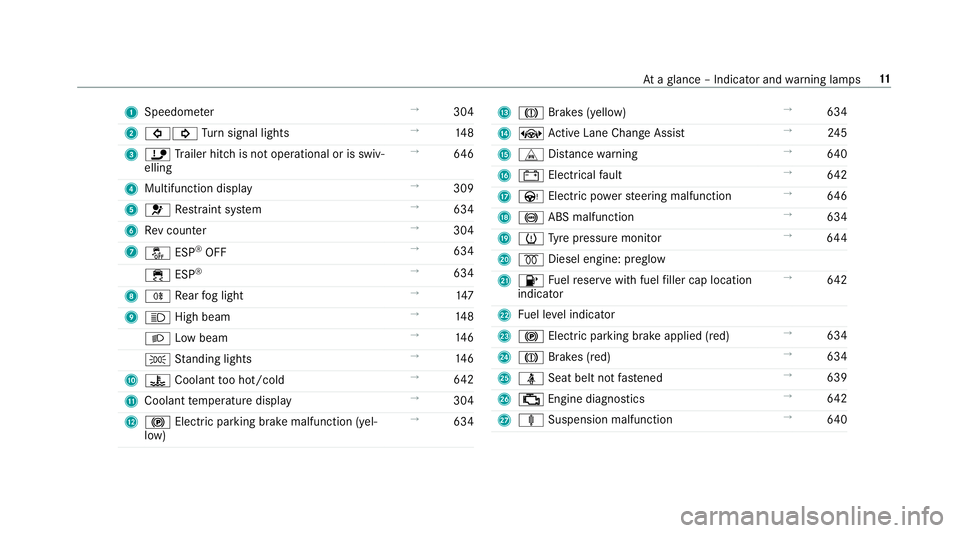
1
Speedom eter →
304
2 #! Turn signal lights →
14 8
3 ï Trailer hit chis not operational or is swiv‐
elling →
646
4 Multifunction display →
309
5 6 Restra int sy stem →
634
6 Rev counter →
304
7 å ESP®
OFF →
634
÷ ESP®
→
634
8 R Rear fog light →
147
9 K High beam →
14 8
L Low beam →
14 6
T Standing lights →
14 6
A ? Coolant too hot/cold →
642
B Coolant temp erature display →
304
C ! Electric pa rking brake malfunction (yel‐
low) →
634 D
J Brakes (yellow) →
634
E ± Active Lane Change Assi st→
24 5
F L Distance warning →
640
G # Electrical fault →
642
H Ù Electric po werst eering malfunction →
646
I ! ABS malfunction →
634
J h Tyre pressure monitor →
644
K % Diesel engine: preglow
L 8 Fuelreser vewith fuel filler cap location
indicator →
642
M Fuel le vel indicator
N ! Electric parking brake applied (red) →
634
O J Brakes (red) →
634
P ü Seat belt not fastened →
639
Q ; Engine diagnostics →
642
R ä Suspension malfunction →
640 At
aglance – Indicator and warning lamps 11
Page 25 of 697
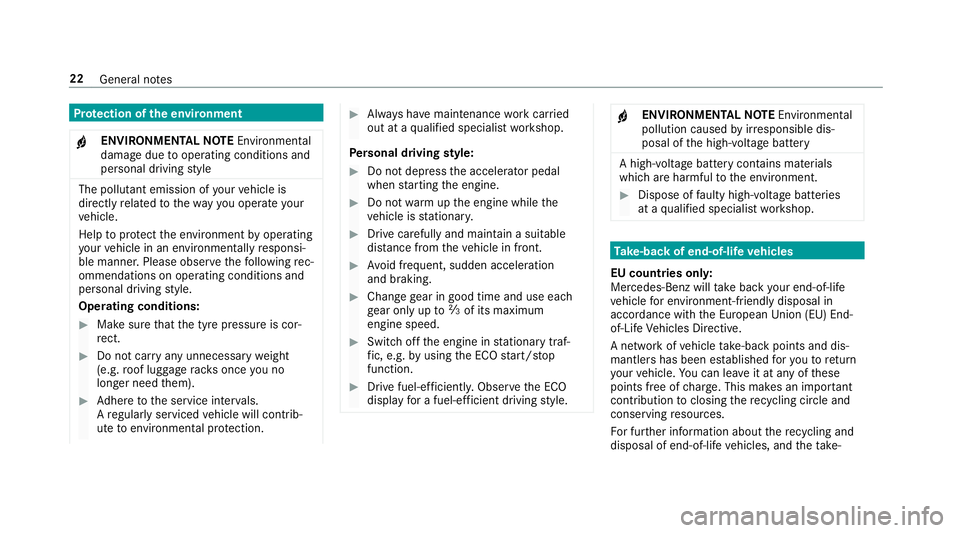
Pr
otection of the environment
+ ENVIRONMENTAL
NOTEEnvironmental
dama gedue tooperating conditions and
personal driving style The pollutant emission of
your vehicle is
directly related tothewa yyo u operate your
ve hicle.
Help toprotect the environment byoperating
yo ur vehicle in an environmentally responsi‐
ble manner. Please obser vethefo llowing rec‐
ommendations on ope rating conditions and
pe rsonal driving style.
Operating conditions: #
Make sure that the tyre pressure is cor‐
re ct. #
Do not car ryany unnecessary weight
(e.g. roof luggage rack s once you no
lon ger need them). #
Adhere tothe service inter vals.
A regularly serviced vehicle will contri b‐
ute toenvironmen tal pr otection. #
Alw ays ha vemaintenance workcar ried
out at a qualified specialist workshop.
Pe rsonal driving style: #
Do not depress the accelera tor pedal
when starting the engine. #
Do not warm upthe engine while the
ve hicle is stationar y. #
Drive carefully and maintain a suitable
di st ance from theve hicle in front. #
Avoid frequent, sudden acceleration
and braking. #
Change gear in good time and use each
ge ar on lyup toÔ of its maximum
engine speed. #
Switch off the engine in stationary traf‐
fi c, e.g. byusing the ECO start/ stop
function. #
Drive fuel-ef ficiently. Obser vethe ECO
display for a fuel-ef ficient driving style. +
ENVIRONMEN
TALNO TEEnvironmental
pollution caused byirre sponsible dis‐
posal of the high-voltage battery A high-voltage battery conta
ins materials
which are harmful tothe environment. #
Dispose of faulty high-voltage bat teries
at a qualified specialist workshop. Ta
ke -back of end-of-life vehicles
EU countries onl y:
Mercedes-Benz will take back your end-of-life
ve hicle for environment-friendly disposal in
accordance with the European Union(EU) End-
of-Life Vehicles Directive.
A network of vehicle take -ba ckpoints and dis‐
mantlers has been es tablished foryo uto return
yo ur vehicle. You can lea veit at any of these
points free of charge . This makes an impor tant
contribution toclosing there cycling circle and
conse rving resources.
Fo r fur ther information about there cycling and
disposal of end-of-li fevehicles, and theta ke- 22
General no tes
Page 207 of 697
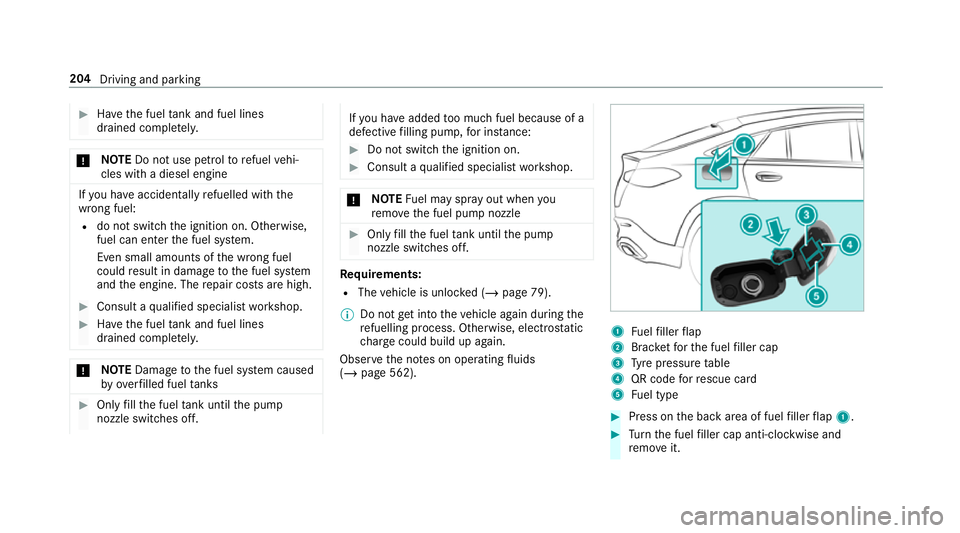
#
Have the fuel tank and fuel lines
drained compl etely. *
NO
TEDo not use petrol torefuel vehi‐
cles with a diesel engine If
yo u ha veacciden tally refuelled with the
wrong fuel:
R do not swit chthe ignition on. Otherwise,
fuel can enter the fuel sy stem.
Even small amounts of the wrong fuel
could result in damage tothe fuel sy stem
and the engine. The repair costs are high. #
Consult a qualified specialist workshop. #
Have the fuel tank and fuel lines
drained compl etely. *
NO
TEDama getothe fuel sy stem caused
by ove rfilled fuel tanks #
Only fill th e fuel tank until the pump
nozzle switches off. If
yo u ha veadded too much fuel because of a
defective filling pump, for ins tance: #
Do not switch the ignition on. #
Consult a qualified specialist workshop. *
NO
TEFuel may spr ayout when you
re mo vethe fuel pump nozzle #
Only fill th e fuel tank until the pump
nozzle switches off. Re
quirements:
R The vehicle is unloc ked (/ page 79).
% Do not get into theve hicle again during the
re fuelling process. Otherwise, electros tatic
ch arge could build up again.
Obser vethe no tes on operating fluids
(/ page 562). 1
Fuelfiller flap
2 Brac ketfo rth e fuel filler cap
3 Tyre pressure table
4 QR code forre scue card
5 Fuel type #
Press on the back area of fuel filler flap 1. #
Turn the fuel filler cap anti-clockwise and
re mo veit. 204
Driving and parking
Page 313 of 697
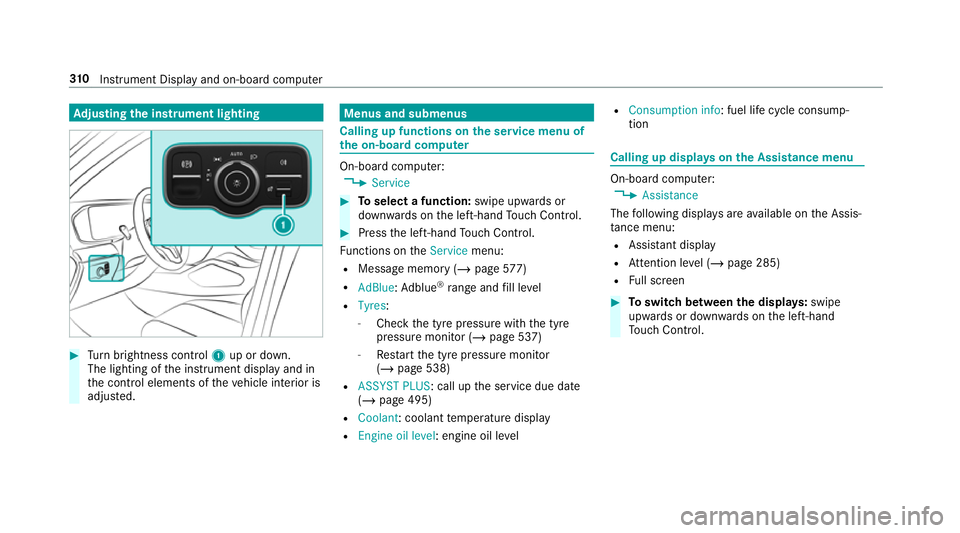
Ad
justing the in stru ment lighting #
Turn brightness control 1up or down.
The lighting of the instrument display and in
th e control elements of theve hicle interior is
adjus ted. Menus and submenus
Calling up functions on
the service menu of
th e on-boa rdcompu ter On-board computer:
4 Service #
Toselect a function: swipe upwards or
down wards on the left-hand Touch Control. #
Press the left-hand Touch Control.
Fu nctions on theService menu:
R Message memory (/ page577)
R AdBlue :Ad blue ®
ra nge and fill le vel
R Tyres:
- Check the tyre pressure with the tyre
pressure monitor (/ page 537)
- Restart the tyre pressure monitor
(/ page 538)
R ASSYST PLUS: call up the service due date
(/ page 495)
R Coolant : coolant temp erature display
R Engine oil level: engine oil le velR
Consumption info: fuel life cycle consump‐
tion Calling up displa
yson the Assistance menu On-board computer:
4 Assistance
The following displa ysare available on the Assis‐
ta nce menu:
R Assi stant display
R Attention le vel (/ page 285)
R Full screen #
Toswitch between the displa ys:swipe
upwards or down wards on the left-hand
To uch Control. 310
Instrument Display and on-board computer
Page 538 of 697
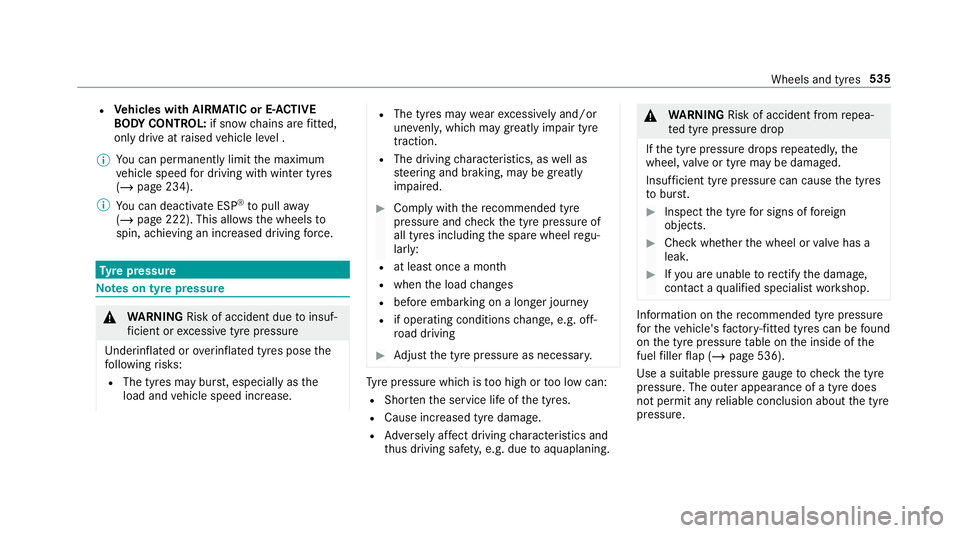
R
Vehicles with AIRMATIC or E- ACTIVE
BO DY CONT ROL:if snow chains are fitted,
only drive at raised vehicle le vel .
% You can permanently limit the maximum
ve hicle speed for driving with winter tyres
(/ page 234).
% You can deactivate ESP ®
to pull away
( / page 222). This allo wsthe wheels to
spin, achieving an increased driving forc e. Ty
re pressure Note
s on tyre pressure &
WARNING Risk of accident due toinsuf‐
fi cient or excessive tyre pressure
Underinfla ted or overinfla ted tyres pose the
fo llowing risks:
R The tyres may bur st, especially as the
load and vehicle speed increase. R
The tyres may wearexc essively and/or
une venly, which may greatlyimpair tyre
traction.
R The driving characteristics, as well as
st eering and braking, may be greatly
impaired. #
Comply with there commended tyre
pressure and check the tyre pressure of
all tyres including the spare wheel regu‐
larly:
R at least once a month
R when the load changes
R before embarking on a lon ger journey
R if operating conditions change, e.g. off-
ro ad driving #
Adjust the tyre pressure as necessar y. Ty
re pressure which is too high or too low can:
R Shor tenth e service life of the tyres.
R Cause increased tyre damage.
R Adversely af fect driving characteristics and
th us driving saf ety, e.g. due toaquaplaning. &
WARNING Risk of accident from repea‐
te d tyre pressure drop
If th e tyre pressure drops repeatedl y,the
wheel, valve or tyre may be damaged.
Insuf ficient tyre pressure can cause the tyres
to bur st. #
Inspect the tyre for signs of fore ign
objects. #
Check whe ther the wheel or valve has a
leak. #
Ifyo u are unable torectify the damage,
conta ct aqualified specialist workshop. Information on
there commended tyre pressure
fo rth eve hicle's factor y-fitted tyres can be found
on the tyre pressure table on the inside of the
fuel filler flap (/ page 536).
Use a suitable pressure gauge tocheck the tyre
pressure. The outer appearance of a tyre does
not permit any reliable conclusion about the tyre
pressure. Wheels and tyres
535
Page 539 of 697
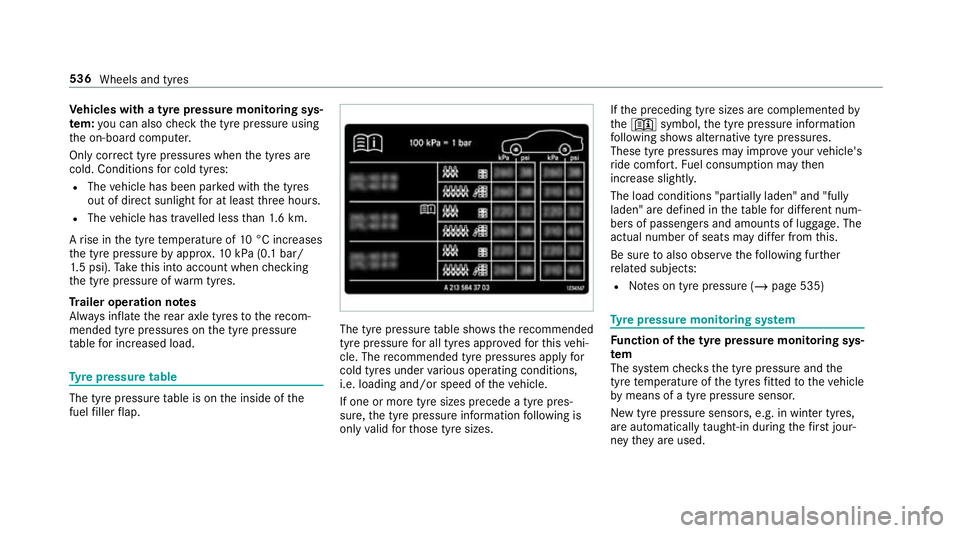
Ve
hicles with a tyre pressure monitoring sys‐
te m: you can also check the tyre pressure using
th e on-board computer.
Only cor rect tyre pressures when the tyres are
cold. Conditions for cold tyres:
R The vehicle has been par ked with the tyres
out of direct sunlight for at least thre e hours.
R The vehicle has tr avelled less than 1.6 km.
A rise in the tyre temp erature of 10°C increases
th e tyre pressure byappr ox.10 kPa (0.1 bar/
1. 5 psi). Take this into account when checking
th e tyre pressure of warm tyres.
Tr ailer operation no tes
Alw ays inflate there ar axle tyres tothere com‐
mended tyre pressures on the tyre pressure
ta ble for increased load. Ty
re pressure table The tyre pressure
table is on the inside of the
fuel filler flap. The tyre pressure
table sho ws there commended
tyre pressure for all tyres appro vedfo rth is vehi‐
cle. The recommended tyre pressures apply for
cold tyres under various operating conditions,
i.e. loading and/or speed of theve hicle.
If one or more tyre sizes precede a tyre pres‐
sure, the tyre pressure information following is
only valid forth ose tyre sizes. If
th e preceding tyre sizes are complemented by
th e+ symbol, the tyre pressure information
fo llowing sho wsalternative tyre pressures.
These tyre pressures may impr oveyour vehicle's
ri de comfort. Fuel consum ption may then
increase slightl y.
The load conditions "partially laden" and "fully
laden" are defined in theta ble for dif fere nt num‐
be rs of passengers and amounts of luggage. The
actual number of seats may dif fer from this.
Be sure toalso obse rveth efo llowing fur ther
re lated subjects:
R Notes on tyre pressure (/ page 535) Ty
re pressure moni toring sy stem Fu
nction of the ty repressure moni toring sys‐
tem
The sy stem checks the tyre pressure and the
tyre temp erature of the tyres fitted totheve hicle
by means of a tyre pressu resensor.
New tyre pressure sensors, e.g. in winter tyres,
are automatically taught-in during thefirs t jour‐
ney they are used. 536
Wheels and tyres
Page 636 of 697
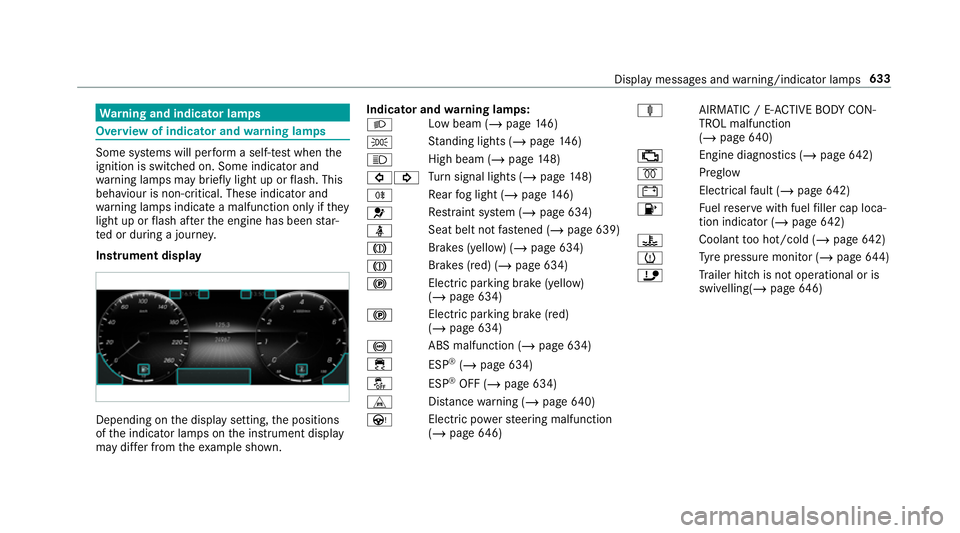
Wa
rning and indicator lamps Overview of indicator and
warning lamps Some sy
stems will per form a self-test when the
ignition is switched on. Some indicator and
wa rning lamps may briefly light up or flash. This
behaviour is non-critical. These indicator and
wa rning lamps indicate a malfunction only if they
light up or flash af terth e engine has been star‐
te d or during a journe y.
Instrument display Depending on
the display setting, the positions
of the indicator lamps on the instrument display
may dif fer from theex ample shown. Indicator and
warning lamps:
L Low beam (/
page146)
T St
anding lights (/ page146)
K High beam (/
page148)
#! Tu
rn signal lights (/ page148)
R Re
ar fog light (/ page146)
6 Re
stra int sy stem (/ page 634)
ü Seat belt not
fastened (/ page 639)
J Brakes (yellow) (/
page 634)
J Brakes (red) (/
page 634)
! Elect
ric pa rking brake (yellow)
(/ page 634)
! Electric parking brake (red)
(/
page 634)
! ABS malfunction (/
page 634)
÷ ESP®
(/ page 634)
å ESP®
OFF (/ page 634)
L Distance warning (/ page640)
Ù Electric powerst eering malfunction
(/ page 646) ä
AIRMATIC / E- ACTIVE BODY CON‐
TROL malfunction
(/ page 640)
; Engine diagnostics (/
page 642)
% Preglow
# Electrical
fault (/ page642)
8 Fu
elreser vewith fuel filler cap loca‐
tion indicator (/ page642)
? Coolan
tto o hot/cold (/ page642)
h Ty
re pressure monitor (/ page644)
ï Trailer hit chis not operational or is
swivelling(/ page646) Displ
aymessa ges and warning/indicator lamps 633
Page 663 of 697
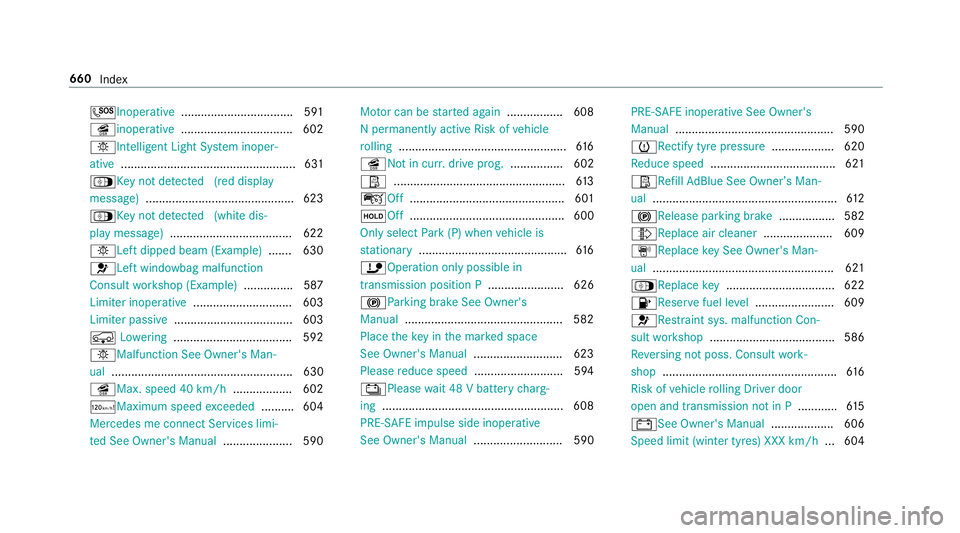
GInoperative
.................................. 591
îinoperative ..................................6 02
bIntelligent Light Sy stem inoper‐
ative ..................................................... 631
ÁKe y not de tected (red displ ay
messa ge).............................................6 23
ÁKe y not de tected (white dis‐
pl ay messa ge).....................................6 22
bLeft dipped beam (Example) ....... 630
6Left wind owbag malfunction
Consult workshop (Example) ............... 587
Limiter inoperative .............................. 603
Limiter passive .................................... 603
 Lowe ring .................................... 592
bMalfunction See Owner's Man‐
ual ....................................................... 630
îMax. speed 40 km/h .................. 602
ðMaximum speed exceeded ..........6 04
Mercedes me connect Services limi‐
te d See Owner's Manual .....................590Mo
tor can be star ted again .................6 08
N permanently active Risk of vehicle
ro lling .................................................. .616
î Notin cur r.drive prog. ................ 602
Ø .................................................... 61 3
ç Off............................................... 601
ëOff ............................................... 600
Only select Park (P) when vehicle is
st ationary ............................................ .616
ï Operation only possible in
transmission position P ....................... 626
!Pa rking brake See Owner's
Manual ................................................ 582
Place theke y in the mar ked space
See Owner's Manual ...........................623
Please reduce speed ...........................5 94
Ý Please wait 48 V battery charg‐
ing ...................................................... .608
PRE-SAFE impulse side inope rative
See Owner's Manual ........................... 590 PRE-SAFE inope
rative See Owner's
Manual ................................................ 590
hRe ctify tyre pressure ................... 620
Re duce speed ...................................... 621
ØRe fill Ad Blue See Owne r’s Man‐
ual ........................................................ 612
! Release parking brake .................582
¸Re place air cleaner .....................609
ÀRe placekey See Owner's Man‐
ual ...................................................... .621
Á Replace key ................................ .622
8Re servefuel le vel........................ 609
6Re stra int sys. malfunction Con‐
sult workshop ...................................... 586
Re versing not poss. Consult work‐
shop ..................................................... 61 6
Risk of vehicle rolling Driver door
open and transmission not in P ............61 5
# See Owner's Manual ................... 606
Speed limit (winter tyres) XXX km/h ... 604660
Index